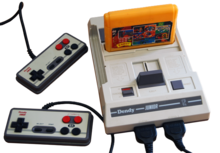 | |
 The Dendy Junior with a cartridge and detachable controllers | |
| Developer | Steepler |
|---|---|
| Manufacturer | TXC Corporation Subor "Tensor" factory, Dubna |
| Product family | Famicom hardware clone |
| Type | Home video game console |
| Release date | |
| Discontinued | 1998 |
| Units sold | 1.5[3] to 6[4] million |
| Media | ROM cartridge |
| CPU | Ricoh 2A03 |
Dendy (Russian: Де́нди) is a series of home video game consoles that were unofficial hardware clones of Nintendo's third-generation Famicom system. Produced from late 1992, Dendy consoles were manufactured in Taiwan using Chinese components on behalf of the Russian company Steepler. These consoles were primarily sold in Russia. Over time, production expanded to include assembly at the Chinese Subor factory and the Russian Tenzor factory in Dubna, Moscow Oblast. The Dendy consoles were based on Japanese hardware designs and cartridge formats, which differed slightly from their American counterparts.
The Dendy product line was divided into two categories: the main Classic series and the budget-oriented Junior series. These categories differed in design, quality, and price. The Classic models were replicas of the Micro Genius consoles produced by Taiwan's TXC Corporation and were manufactured in the same factory. The Junior models, developed specifically for Steepler, employed a cost-effective design based on a system-on-a-chip architecture. Steepler also planned to release a Pro version featuring one wired and one wireless gamepad. However, this model was only produced in a single, limited batch.
Because the Famicom and Nintendo Entertainment System were never officially sold in post-Soviet states, the Dendy achieved great popularity in the region. It was promoted through television programs and video game magazines. Dendy became a household name in Russia and began to be applied to the rest of the Famicom hardware clones, colloquially called Famiclones, and to other consoles. After the bankruptcy of Steepler, sales of the original Dendy ceased in 1998, and at the time, according to various estimates, between 1.5 and 6 million units were sold. It is believed that it created a market for video games and game consoles in Russia.
- ^ Cite error: The named reference
k33856was invoked but never defined (see the help page). - ^ Cite error: The named reference
Kostinwas invoked but never defined (see the help page). - ^ Cite error: The named reference
escapistwas invoked but never defined (see the help page). - ^ Cite error: The named reference
secretmagwas invoked but never defined (see the help page).